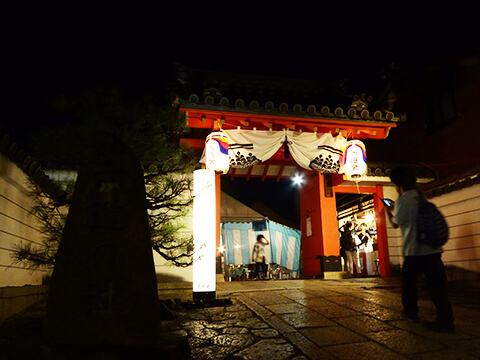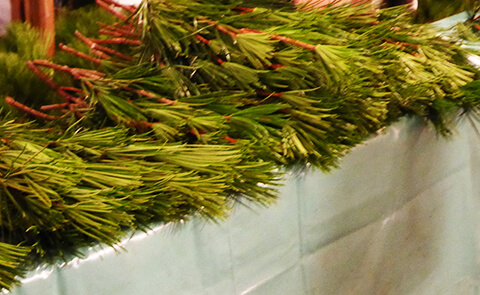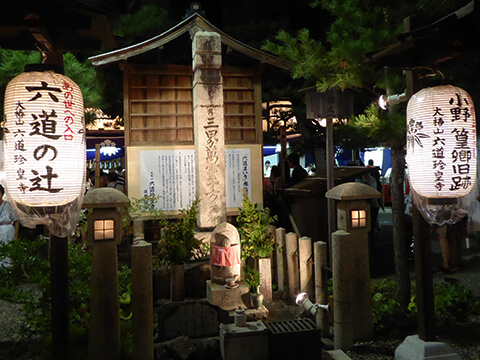
PR
In Kyoto since ancient times,A place that has been believed to be the boundary between the other world and this world.There was a The entrance to Toribeno in Higashiyama, known as one of the three major funeral sites in KyotoRikudou no TsujiBut that's it.
During the Heian period (794-1185), when a person died, except for a few people such as aristocrats, the body was sent off to the field, and those who accompanied the deceased said their final farewells to the dead at Rikudo no Tsuji. Since the bodies were wind-buried (left out in the open) from this street ahead, there were bodies lying all over the place, emitting a stench of decay, and the world of the dead spread out with human bones scattered about.
that (something or someone distant from the speaker, close to the listener)Rikudo-jinnoji Temple at the crossroads of the six roads separating the worlds of the living and the dead.There is.
Every year, from August 7 to 10, this templeRikudo mairi, an event to welcome the spiritsThe festival is held at the Rikudo-Jinno-ji temple. At dusk, we made our way to Rikudo-Jinnoji Temple, lit by lanterns. The high temperature that day was 37 degrees Celsius. The heat did not go away even after the sun went down.

To Rikudo-Jinnoji Temple
In front of the gate and on the approach to the gate, bonbana andumbrella pinewere sold. Koya-maki is a sacred tree that is believed to be inhabited by spirits, and spirits are said to return to this world using it as a vessel of refuge.

Koya-maki sold at Rikudo-Jinnoji Temple
The temple grounds were filled with the blue fragrance of Koya-maki (Japanese cedar), which somewhat dredged up the humid air. The sound of the bells ringing continuously was the sound of the "welcoming bells. The bells were ringing one after another to welcome the visitors to the temple, which is believed to bring them to the other side of the world.
In fact, there is a well on the temple grounds that retains a mysterious legend to this day.
Since ancient times, the people of Kyoto have believed that the bottom of the well is connected to the underworld and that one can go to the other world by descending through the Koya-maki. In "Konjaku Monogatari (Tales of Ancient and Modern Times)," there is a story about a man who used the well to go to the other side of the world every night. This person is the actual person who existed in the early Heian period (794-1185).Ono bamboo groveIt is. Takamura is a bureaucrat and Chinese poet,During the day he was available to the court, and at night he went to the underworld from the well at Rikudo-Jinno-ji Temple to work as one arm of King Yama.It is said.

Lanterns in the precincts of Rikudo-Jinnoji Temple (Rikudo no Tsuji. (There is an entrance to the afterlife)
When I visited Rikudo-Jinnoji Temple about 10 years ago to cover the magical world of Kyoto, I had the opportunity to see the well where Takamura used to go to the underworld. At the time, the well was buried halfway up with dead leaves. The well was dry and there was no evidence of water having been drawn from it. Incidentally, when the area around the well was carved, a number of Jizo statues were said to have been found.
Ono Takamura, the hero of the Takamura legend, was a large man of about 186 cm, far exceeding the average height of the time. He was also a brilliant Chinese poet who was not afraid to address even the emperor, and he was also a great poet and poet, and was a great poet of the three major burial grounds in Kyoto, including Toribeno, or the "three burial grounds of Kyoto.Jurisdictor of the other worldThis must have made people fearful of the area and gave birth to strange legends.
The statue of Takamura is enshrined in the hall of this temple along with the statue of King Yama. During the Rikudo Mairi, the lattice door is removed and the statue can be seen in person. Since photography is not allowed, I was able to see the statue of Takamura, who, as legend has it, is a stately, stalwart man with a keen gaze, as if he is staring at the other side of the world and at this world.
Now, in this area of Rokudo Tsuji, there is a legend that a woman who died and gave birth to a child in her grave becomes a ghost and comes to buy candy for her child.Long-established "ghost child care candyand the nine-phase paintings of Empress Danglin, which depict nine stages of hell (Rikudo-e) and the decay of a corpse during the Six-Path Mairi (six-way visit),Saifukuji TempleThere is.

Child-rearing ghost candy lanterns
Even though the custom of wind burial has been lost, it is still possible to see the remnants of the Rokudo no Tsuji,How the people of Kyoto have both feared and respected this place.This would be the end of the story.
Obon in Kyoto is celebrated with the Rikudo-jinnoji temple's Rikudo mairi to welcome the spirits of ancestors.
After spending some time with their families, the spirits will return to the other world at the Gozan-no-Okuribi (Bonfire of the Five Mountains) on the 16th.
Tradition that exists everywhere in the city of Kyoto. It is not just a picture, it is secretly alive in this modern age and continues to coexist with people. The two of Office TO, who previously wrote a series of articles "Kyoto's Demon World Exploration" in the monthly magazine Leaf, explore the mysterious "different" world of Kyoto, which was created over 1200 years. I will unravel the story while actually visiting the place. .
 News
News Feature article
Feature article Featured event
Featured event